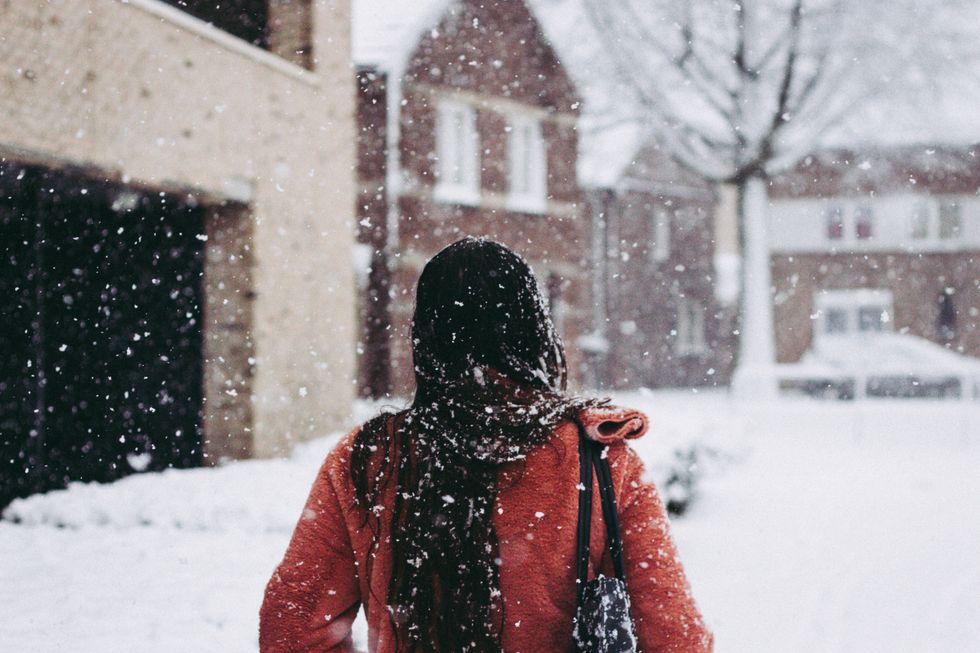I stand by the doors as I bundle up and prepare for my journey through the frigid cold. I put on a fuzzy hat to cover my ears from the icy winds. I pull up my hood to enshroud my face from the biting flakes of falling snow. I'm layered with jackets and t-shirts, gloves and socks, and sweatpants and extra pants that Mom insisted I wear whenever winter hits. Though I don't fret that winter has come once again in late-January, that doesn't mean I don't take it seriously. I put on my headphones to provide music and keep me going through the night.
Darkness hasn't just fallen - it has slipped and plummeted headfirst into the city, just like students struggling to walk across campus. A layer of ice coats the sidewalks, yet it is misleadingly thin, making the treacherous path seem like it is just wet from rain—which it also is. The streets are caked with snow as drivers make slow, deliberate turns and stops, especially at intersections.
It seems as though winter isn't just going through the motions of making a cameo appearance towards the end of January. Rather, it has seized the populated areas and implanted itself within the minds of everyone taken in its grasp. Winter weather thus represents a challenge, an affront to our commutes, to our ease of movement, to the very purpose of infrastructure that seeks to make streamline our transportation.
I press play on my phone as I begin to walk to a meeting at the student publications building. "Juntos" is playing, a song by Colombian artist Juanes that means "together." My footing is already unsteady—my ankles and legs ache from my deliberate short steps reminiscent of a penguin's waddle. I repeatedly slip as one foot pushes ahead while the other stays planted behind. It feels as though my body is at odds with itself as I want to carve ahead while also stopping where I am for a moment of rest. The same winter sidewalks I traversed with ease years ago on a track and field team are suddenly much more intimidating when taken more slowly.
While no longer being adept at navigating the icy ocean is certainly a disappointment, I still notice and feel the mutual struggle among a collective. All around me are students with the same penguin waddle to get where they need to go, the same hesitancy to cross a street as a car slows to a stop, the same measured attempts at balance within an unbalanced terrain. One girl catches her laughing friend as she very nearly plummets into a patch of ice. Others take unconventional routes to their destinations, clumping into paths protected by ceilings that avoided the icy plague. Despite the chilling solitude of winter, we find ways to persevere, no, thrive together in the climate thrown at us.
I head down a ramp leading towards the publication building. When I slip and catch myself on the railing, the woman far ahead me stops to ask if I'm alright. When I respond, she offers a reassuring smile and turns back to continue onwards. At one point I see her trudging through the snowy field, and I stop to question why. When I reach the field, I see a single path of footsteps that lead across to a library. They are numerously spread out and dug into the snow in such a manner that no single person could've left them.
One brave student paved a more secure path for potentially hundreds after him/her to follow in their footsteps. The unspoken unity of students within the circumstances presented before them is empowering and inspiring. There's a presumed level of cooperation as students put in a mild effort to better the situation for themselves and others that followed. The snow mounds and the encroaching ice cannot stop us from flexing our own humanity for the sake of ourselves and those around us.
I waddle on as I place my feet in the footprints left behind for me, hoping to take the same considerate and subtle attitude of creating a better future for those that will follow long after I am gone, not because it will benefit me in particular, but because it is the right step to take.



















